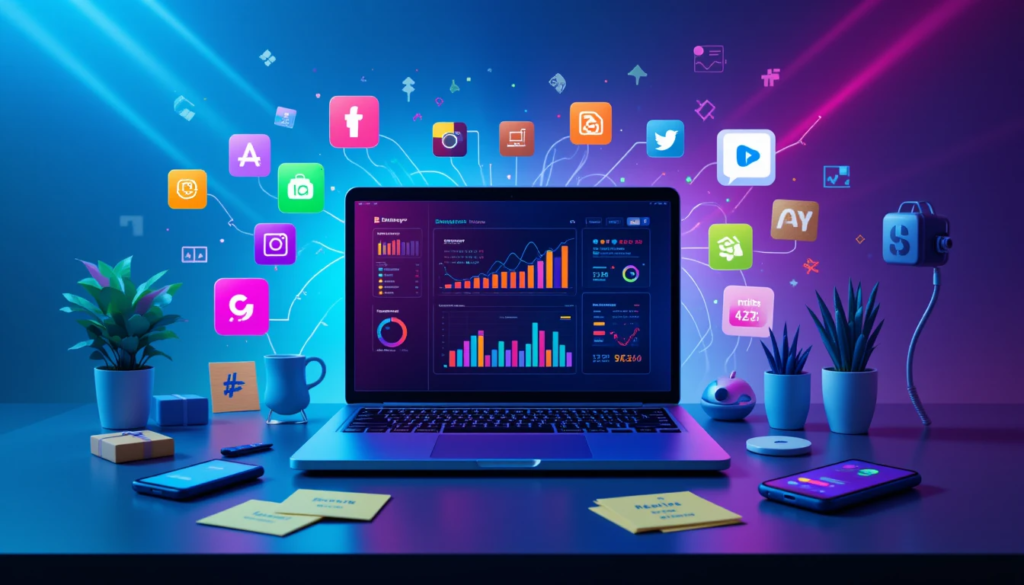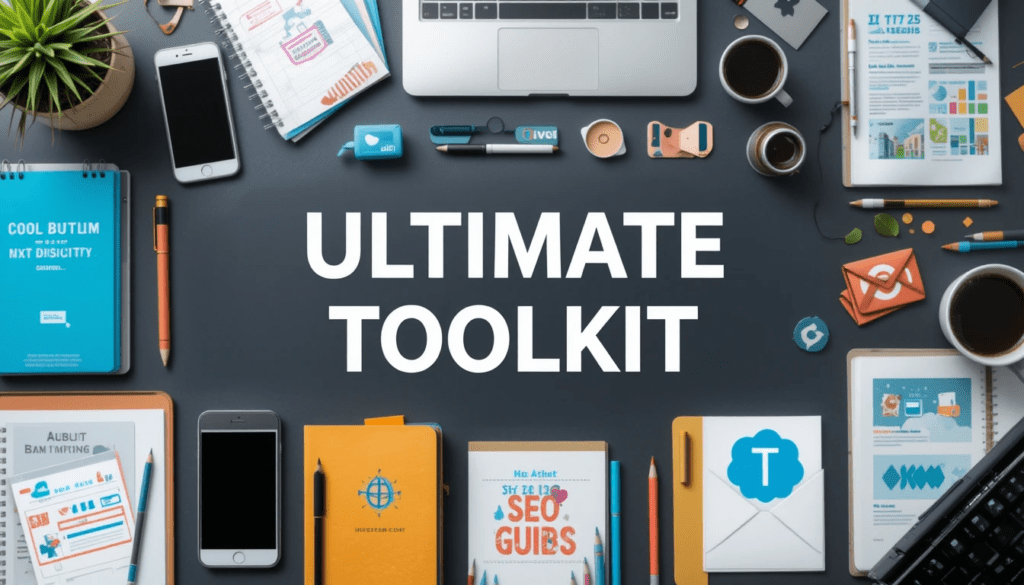Introduction:
Small businesses in 2025 face unique challenges. They must navigate the dual hurdles of increasing competition while continuously adapting to shifting customer trends, which proves challenging in execution. Companies must convert to contemporary marketing solutions because traditional methods cannot fulfill market needs. The essential digital marketing tool serves as our professional lifeline.
77.8% of small companies depend on digital marketing strategies to generate revenue. These statistics demonstrate how essential digital marketing has become for today’s market landscape. It has evolved from an optional extra to an essential business tool for enhancing brand visibility and increasing sales.
What is Digital Marketing?
Digital marketing is the art of promoting products or services through online platforms and cutting-edge marketing tools. It’s all about meeting customers where they spend most of their time—on the internet—and engaging them in a way that’s relevant and impactful.

Here are the key components of Digital Marketing:
SEO (Search Engine Optimization): Online strategies help make websites rank higher in search engine results.
Social Media: Businesses should use social media tools, including Instagram, Facebook, and TikTok, to connect with their customer base.
Paid Ads: Small businesses use paid advertisements on Google, Facebook, and other websites to find new prospective customers.
Content Marketing: Producing valuable digital assets, such as blogs, videos, and infographics, increases audience engagement.
Email Marketing: Your marketing strategy includes personalized email communication that connects with customers to generate sales performance.
What’s driving small businesses to turn to digital marketing today?”
Digital marketing offers several key advantages, especially for small businesses
Cost-Effectiveness: Digital marketing eliminates the expense of traditional marketing models since businesses can connect with significant audiences at sensible prices.
Measurable Results: You will receive precise data about your marketing campaign performance, which you can use to modify your campaigns.
Global Reach: Small businesses can connect with global customers through digital tools, which makes them competitive against their larger industry counterparts.
Through platforms including Instagram, TikTok, and Google Ads, small businesses find tools for effective marketing, enabling them to challenge established players in their market.
The Key Elements of a Digital Marketing Toolkit
A successful digital marketing toolkit needs the following essential items to help small businesses reach their goals.
Social Media Marketing
Your customers reserve significant time on social media platforms, so developing a solid presence is critical. In 2025, focus on platforms like:
Instagram: For visually engaging content.
Facebook: Your digital marketing toolkit must function to engage multiple user demographics.
TikTok: Your videos should be brief and imaginative when targeting audience engagement.
Strategies for engagement: Integrating reel videos and Stories content with paid ad features helps increase market exposure while encouraging audience participation.
SEO for Small Businesses
Online businesses need SEO to draw attention from search engines. Focus on three main areas:
On-Page SEO: Your website content optimization helps improve your placement in search result pages
.
Off-Page SEO: Your website benefits from purposeful link building from distinguished online platforms, which boosts its search ranking authority.
Local SEO: Your company needs to engage its target market through standard search engine listings for local goods and services.
Three essential SEO monitoring and optimization tools work together through Google Search Console, Ahrefs, and SEMrush.
Content Marketing
Content marketing works to create meaningful content that attracts and nurtures target audiences.
Blogs: Publish written guidance, tutorials, and market-specific education materials that help your target audience.
Videos: Your audience can see clear instructions combining product tutorials with exclusive company video content and glimpses of their internal workspace activities.
Infographics: Complex data points require presentation methods that simplify comprehension.
Paid Ads
Through paid advertising, businesses can quickly expand their client base while connecting with new potential customers.
Google Ads: Your marketing content will appear in the first spot of search results that match specific user queries.
Facebook Ads: create marketing campaigns to match user needs across behavior, characteristic profiles, and recorded actions.
Remarketing: Display advertisements on platforms for customers who already visited your website.
Email Marketing
Through email marketing, businesses gain the ability to create a dedicated clientele. Start by.
Building a Subscriber List: To encourage email subscriptions, you should offer unique values through discounts while giving away free guides.
Automating Campaigns: Automation tools allow you to send targeted email sequences that guide leads toward becoming paying customers.

Step-by-Step Guide: How to Build Your Digital Marketing Strategy
A complete digital marketing strategy development process requires dedicated time to deliver valuable outcomes.
Here’s how to get started:
Define Your Goals: Which part of your organization involves elevation – recognition power or direct revenue growth?
Your strategy is shaped by the clear direction set by your specific goals
Identify Your Audience: Know your marketing audience by developing buyer personas, which will help you understand their needs and preferences.
Choose Your Channels: Pick your tools and platforms based on who your audience is
Create and Schedule Content: Your content production workflow should happen in advance so you can maintain continuous posting schedules.
Measure Results and Optimize: Analytics tracking tools will help you identify performance changes that will allow you to modify your strategy.
Tools and Resources
Achieving digital marketing success requires the right tools. Here are some essentials for small businesses:
- SEO: Ahrefs, SEMrush
- Social Media: Hootsuite, Buffer
- Analytics: Google Analytics”
Success Stories and Case Studies
Digital marketing provides substantial success for businesses with smaller operations. For example:
A small bakery achieved a 40% sales rise throughout six months through its Instagram ad efforts and localized search engine optimization.
The fitness studio expanded its online community by 50% through TikTok videos and email newsletters.
Two successful examples demonstrate how small businesses can use digital marketing strategies to ramp up their operations.
FAQs
Which platforms should businesses in this size range use?
To kick off your small business digital marketing, start with Facebook, Google Ads, and Instagram.
How much should be allocated when budgeting for digital marketing?
For small businesses with limited budgets, it’s recommended to dedicate 5 to 10 percent of revenue toward marketing expenses, gradually increasing this amount as investments begin to show results.
How long should businesses expect to wait for visible outcomes from digital marketing strategies?
The timeline for results can vary. SEO typically takes three to six months to show significant results, while paid ads generate more immediate engagement.
Conclusion
Digital marketing will function as the essential promotional instrument for small businesses throughout 2025. Digital marketing tools help your business remain competitive and expand your customer reach, which leads to business expansion. Are you prepared for digital marketing growth at the highest level?
Let’s Build Your Strategy Together!

